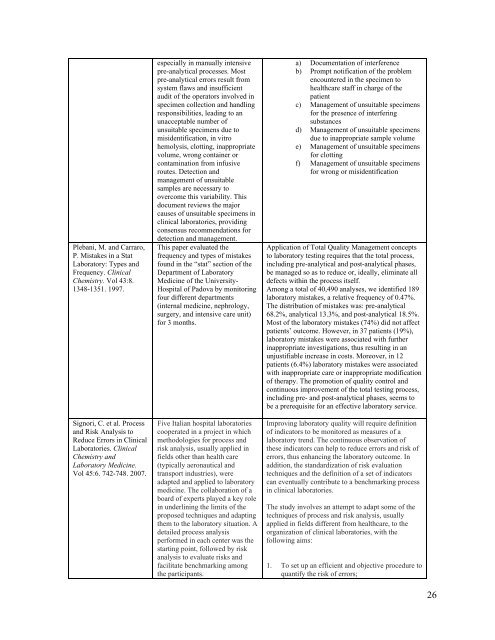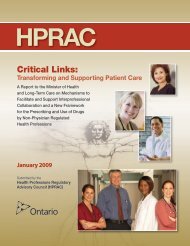Scope Of Practice Review - Health Professions Regulatory Advisory ...
Scope Of Practice Review - Health Professions Regulatory Advisory ...
Scope Of Practice Review - Health Professions Regulatory Advisory ...
Create successful ePaper yourself
Turn your PDF publications into a flip-book with our unique Google optimized e-Paper software.
Plebani, M. and Carraro,P. Mistakes in a StatLaboratory: Types andFrequency. ClinicalChemistry. Vol 43:8.1348-1351. 1997.Signori, C. et al. Processand Risk Analysis toReduce Errors in ClinicalLaboratories. ClinicalChemistry andLaboratory Medicine.Vol 45:6. 742-748. 2007.especially in manually intensivepre-analytical processes. Mostpre-analytical errors result fromsystem flaws and insufficientaudit of the operators involved inspecimen collection and handlingresponsibilities, leading to anunacceptable number ofunsuitable specimens due tomisidentification, in vitrohemolysis, clotting, inappropriatevolume, wrong container orcontamination from infusiveroutes. Detection andmanagement of unsuitablesamples are necessary toovercome this variability. Thisdocument reviews the majorcauses of unsuitable specimens inclinical laboratories, providingconsensus recommendations fordetection and management.This paper evaluated thefrequency and types of mistakesfound in the “stat” section of theDepartment of LaboratoryMedicine of the University-Hospital of Padova by monitoringfour different departments(internal medicine, nephrology,surgery, and intensive care unit)for 3 months.Five Italian hospital laboratoriescooperated in a project in whichmethodologies for process andrisk analysis, usually applied infields other than health care(typically aeronautical andtransport industries), wereadapted and applied to laboratorymedicine. The collaboration of aboard of experts played a key rolein underlining the limits of theproposed techniques and adaptingthem to the laboratory situation. Adetailed process analysisperformed in each center was thestarting point, followed by riskanalysis to evaluate risks andfacilitate benchmarking amongthe participants.a) Documentation of interferenceb) Prompt notification of the problemencountered in the specimen tohealthcare staff in charge of thepatientc) Management of unsuitable specimensfor the presence of interferingsubstancesd) Management of unsuitable specimensdue to inappropriate sample volumee) Management of unsuitable specimensfor clottingf) Management of unsuitable specimensfor wrong or misidentificationApplication of Total Quality Management conceptsto laboratory testing requires that the total process,including pre-analytical and post-analytical phases,be managed so as to reduce or, ideally, eliminate alldefects within the process itself.Among a total of 40,490 analyses, we identified 189laboratory mistakes, a relative frequency of 0.47%.The distribution of mistakes was: pre-analytical68.2%, analytical 13.3%, and post-analytical 18.5%.Most of the laboratory mistakes (74%) did not affectpatients’ outcome. However, in 37 patients (19%),laboratory mistakes were associated with furtherinappropriate investigations, thus resulting in anunjustifiable increase in costs. Moreover, in 12patients (6.4%) laboratory mistakes were associatedwith inappropriate care or inappropriate modificationof therapy. The promotion of quality control andcontinuous improvement of the total testing process,including pre- and post-analytical phases, seems tobe a prerequisite for an effective laboratory service.Improving laboratory quality will require definitionof indicators to be monitored as measures of alaboratory trend. The continuous observation ofthese indicators can help to reduce errors and risk oferrors, thus enhancing the laboratory outcome. Inaddition, the standardization of risk evaluationtechniques and the definition of a set of indicatorscan eventually contribute to a benchmarking processin clinical laboratories.The study involves an attempt to adapt some of thetechniques of process and risk analysis, usuallyapplied in fields different from healthcare, to theorganization of clinical laboratories, with thefollowing aims:1. To set up an efficient and objective procedure toquantify the risk of errors;26
















